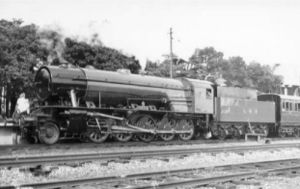Longmoor Military Railway

The Longmoor Military Railway (LMR) was a British military railway in Hampshire, built by the Royal Engineers from 1903 in order to train soldiers on railway construction and operations.
Contents
Route
Authorised for construction from 1902, activities date from 1903 when a 1 ft 6 in (457 mm) gauge tramway was laid to assist in removing seventy corrugated iron huts from Longmoor Military Camp to Bordon.
The railway was relaid to standard gauge in 1905-1907 and was initially known as the Woolmer Instructional Military Railway. It was renamed the Longmoor Military Railway in 1935. The Liss extension was opened in 1933. The stations and junctions included:
- Bordon - the northern terminal, adjacent to Bordon station and with access to British Railways via the LSWR owned Bentley and Bordon Light Railway
- Bordon Camp
- Whitehill Junction
- Two Range halt
- Longmoor Camp - the original terminus, and largest station on the line
- Weaversdown Halt - originally a passing place, a station was constructed which served the eastern side of Longmoor Military Camp
- Liss Forest
- Liss Junction - with access to the exchange sidings, and onwards into Liss British Railways goods yard
- Liss - the southern terminus, with a platform adjacent to Liss railway station
An additional loop ran eastwards from Longmoor camp via a station at Hopkins Bridge to Whitehill Junction, completed in 1942. This provided circular running to the line, allowing for improved training without the need to turn trains at the terminals.
As a training railway, it was often being constructed/deconstructed. The layout would often change, and at one time housed a machine which could lay 1,500 yards of track a day. At its peak, the railway ran to over 70 miles of operational laid track and sidings.
Operations
The vehicles and stock on the LMR were very much an assortment to give the maximum learning opportunity. Well over a thousand locomotives had associations with the railway, although many only through the need for storage. The same was true of the signalling at the various locations on the line, including an Army version of flag signalling. After the end of World War II, the collection also included captured enemy equipment, inclduing a German trailer which dragged behind it a huge hook, used to destroy sleepers and so render railway lines unusable to advancing enemy troops.
In addition to the various military items, there were old versions of standard passenger carriages. A passenger service was operated over the line at various times, nominally for personnel required on the railway, and others from the War Department/Ministry of Defence and their families.
With a declining role for railways both in Britain and the rest of the world, it was inevitable that the significance of the facilities offered by the LMR would be reduced in later years. Even so, the LMR was still important enough for the tracks of the Bentley to Bordon branch to be left in place when passenger services were withdrawn on 16 September, 1957. This line remained in place as, although there was a British Railways connection at Liss, the Bordon branch made it easier to accommodate the movements of military traffic at short notice. In 1966, the movement of goods over the Bordon branch was suspended, and the line was taken up in 1967.
Railway Inspectorate
Among those who were learned the workings of railways on the LMR, there were a select band who continued in railway-related work after leaving the services. These were the members of the Railway Inspectorate, whose remit is to enquire into the circumstances surrounding British railway accidents. The first Chief Inspecting Officer of Railways not to have been trained in the army was R. J. Seymour, appointed in 1988.
Closure
In light of the reducing role of the military and the severely reduced British Empire, it was decided by the Ministry of Defence to close the railway. On hearing of its impending closure local locomotive preservation groups became interested in acquiring the small but complete rail system, and a bid was placed to purchase LMR along with the airstrip at Gypsy Hollow which would have enabled the production of a unique transport museum. The MOD rejected this proposal, which had been backed by the Association of Railway Preservation Societies and The Transport Trust. However the Army did offer the last 1½ miles of line from Liss Forest Road to Liss. The offer was accepted, a provisional lease was drawn up and planning permission was sought for developments at Liss [1]
Unfortunately the people of Liss did not share this enthusiasm and opposed the planning permission. Several residents raised £9,100 in a successful bid to buy this last piece of line. Longmoor Military Railway closed down on 31 October, 1969, though for another two years some locomotives and stock remained on site, and there were occasional movements.
Preservation
Some of the stock of the LMR did pass into the hands of preservationists, and some was also bequeathed to the Museum of Army Transport at Beverley, Yorkshire, including:
- WD Austerity 2-10-0 - LMR 600 Gordon
- Hunslet Austerity 0-6-0ST - No.118 Brussels
References
- Mitchell, V. and Smith, K., (1987), Branch Lines to Longmoor, Middleton Press, ISBN 0-906520-41-X
